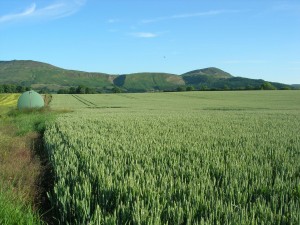Download pdf: High Yields – are we keeping up with Potash offtakes? (1.67M)
pdf 1.67M
High Yields – are we keeping up with Potash offtakes?
September 2014
 The Fertiliser Manual (RB209) gives recommendations for phosphate and potash applications for arable crops and grass based on that needed to replace the amount that will be removed from the soil by crop offtake at harvest. In addition, where soil analysis is below target, it adds a small amount to build up the soil reserves over a long period of time. Also, for some specific crops, it will recommend higher amounts because they are “responsive” crops for that nutrient e.g. potatoes and phosphate.
The Fertiliser Manual (RB209) gives recommendations for phosphate and potash applications for arable crops and grass based on that needed to replace the amount that will be removed from the soil by crop offtake at harvest. In addition, where soil analysis is below target, it adds a small amount to build up the soil reserves over a long period of time. Also, for some specific crops, it will recommend higher amounts because they are “responsive” crops for that nutrient e.g. potatoes and phosphate.
In order to produce “typical” recommendations for phosphate and potash, RB209 chooses a “typical” yield for the crop and quotes the recommendation for that yield in a tabular form. Users with average yields will therefore see the recommendation easily, however for those with higher yields an addition is needed for the extra crop’s nutrient offtake, and we use the values on p228 in RB209 or PDA leaflet “Nutrients in crop material”.
The concern is that with many farms regularly producing well above the “typical” yield, the applications of phosphate and potash are not being adjusted and so will be inadequate. The result of this will be falling soil indices and reduced yields of the following crops. This process happens slowly and the cause of the lower yields is not always apparent (usually we blame the weather). Often it is not until the routine soil analysis is done that the cause appears. With grass for silage, especially, the problem is that we often do not know the yields on the farm and so we just use the “typical” values.
Some examples are shown below comparing the typical RB209 yield recommendation with the recommendations for some regularly achieved higher yields (assuming soil indices are at target; index 2 for P and 2- for K). They clearly show how much more nutrient is needed.
Grass for Silage (25%DM) over 2 cuts
I have taken 48t/ha as an example of achievable high yields. It is this year’s average yield for 2 cuts for in Yara’s Grass Prix competition, which come from all over the UK and Ireland. It is about 25% higher than “typical”
| Tonnes/ha | P2O5 offtake kg/ha | K2O offtake kg/ha | |
| RB209 yield (23t+15t) | 38 | 65 | 228 |
| High yield | 48 | 82 | 288 |
It shows that for high yielding grass crops the requirement is substantially above the values shown in the table for typical yields of grass for silage. This emphasises the importance of measuring silage grass yields on farm for future reference when making such recommendations.
| Tonnes/ha | P2O5 offtake kg/ha | K2O offtake kg/ha | ||
| Forage Maize (30%DM) | RB209 yield | 40 | 56 | 176 |
| High yield | 60 | 84 | 264 | |
| Fodder Beet (roots only) | RB209 yield | 65 | 52 | 260* |
| High yield | 85 | 68 | 340* | |
| Winter Wheat (grain & straw) | RB209 yield | 8 | 65 | 85 |
| High yield | 10 | 84 | 104 | |
| Winter Oilseed Rape (seed only) | RB209 yield | 3.5 | 50 | 40 |
| High yield | 5 | 70 | 55 | |
| *using updated values (ref PDA leaflet No 16) | ||||
| Tonnes/ha | P2O5 offtake kg/ha | K2O offtake kg/ha | ||
| Sugar Beet (roots only) | RB209 yield | 60 | 48 | 102 |
| High yield | 80 | 64 | 136 | |
| Potatoes (maincrop) | RB209 yield | 50 | 50* | 300 |
| High yield | 65 | 65* | 377 | |
| *responsive to phosphate, so recommendation will be much higher e.g. 170 at index 2 | ||||
This exercise demonstrates the need for good yield estimates for the farm when making phosphate and potash recommendations, and shows the danger of simply reading off the recommendations in the “typical” tables in RB209.
These recommendation calculations can be done very easily using the PDA Calculator on our website. It is also available to use on your smartphone or tablet.
The nutrient requirement may be supplied by fertilisers and/or organic manures. Where organic manures are used, the application rate needs to be measured to ascertain their true contribution. Laboratory analysis of manure samples is worthwhile, provided a proper sampling protocol is followed (ref RB209, p230).

